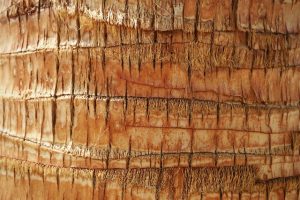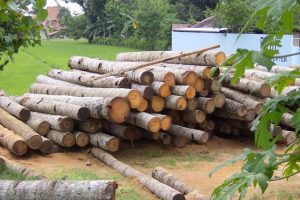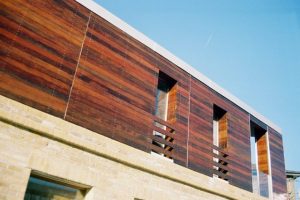Coco lumber
Source plants
- scientific name
- Cocos nucifera L.
- general name
- Coconut palm
- overview
-
Origin and geographical distribution
The coconut palm, the origin of which is believed to be in Polynesia or tropical Asia, is widely cultivated in the tropics across the world, from 26˚ N to 26˚ S, except inland Africa and inland South America. Natural coconut palms have not been confirmed. Coconuts are roughly classified into two major varieties: the niu kafa type, with highly ridged fruits with thick husks, and the niu vai type, with round fruits with thin husks and a larger endosperm to husk ratio. Coconuts are also classified into tall var. typica and dwarf var. nana, which are genetically distinct; the dwarf variety was artificially selected for ornamental traits, and for early germination and fruiting. The tall variety is an outcross and the dwarf variety is an incross, with the former having much greater genetic diversity.Morphological characteristics
Coconut trees grow up to 30 m tall. The trunk is straight but grows slightly obliquely, and many bend in the middle. Their pinnate leaves are 4–6 m long, with long thin pinnae (60–90 cm from the base to the tip). The leaves are concentrated at the top of the trunk, where leaf bases, and fibers that come out of them, grow in high density. Below there, the trunk surface is relatively smooth. Being monoecious, the palm produces large panicles with male flowers at the top and female flowers at the base. The fully matured fruits measure up to 30 cm in diameter, have a shape of a slightly pointed ellipse and are green in color. The fruit has a thick outside layer of strong fiber that covers the seed with a very hard shell. The fruit floats in seawater, allowing it to travel long distances.Growth and development
The coconut palm thrives on sandy soils and is highly tolerant of salinity; therefore, they form long strips of colonies along the shorelines of the tropics. It prefers areas with abundant sunlight and regular rainfall (1,500–2,500 mm/year), grow best at summer temperatures between 28 ˚C and 37 ˚C, tolerate some seasonal variation, and survive winter temperatures between 4 ˚C and 12 ˚C. While coconuts survive short drops to 0 ˚C, they do not grow in cold climates; severe frost is usually fatal. They also need high humidity (≥70%) for optimum growth, which is why they are rarely seen in dry areas with low humidity. However, they can be found in humid areas with low annual precipitation such as in Karachi, Pakistan, which receives only about 250 mm of rainfall per year, but is consistently warm and humid. Young coconut palms require an environment with no or little overhead canopy, as they need direct sun to grow. Coconut palms can grow in a wide range of soil types but prefer soils with good aeration and drainage (loamy or sandy soil). While they thrive in coastal areas, they can grow in inland areas, if climatic conditions are met. They do not, however, grow in rocky, laterite, water-stagnant soil.Ecological characteristics
The fruits’ ability to float in the sea means that after falling into the sea, they are carried long distances by currents, wash up on a beach, and germinate there, thereby expanding the distribution. Their northern limit of natural distribution is nearly the same as the line of the coldest month’s mean temperature of 18 ˚C, which is the border between the tropical and temperate zones in Koppen’s classification.
Product characteristics
- use
- Building material, furniture material, crafts
- area
- Southeast Asia, tropical America, tropical Africa
- overview
-
Its wood is reminiscent in appearance to mahogany; however, coconut timber has a much more fibrous grain than mahogany and lacks mahogany’s pearl-like gloss. Color tones and hues range from golden to near ebony, with dark brown flecks. There are three basic color divisions relating to the timber’s density: dark brown tones (high density), medium brown tones (medium density), and light golden tones (low density). Coconut trees have no annual growth rings, rays, heartwood, or branches, meaning that coconut timber is free from knots and other such imperfections. The hardest, densest part of the wood is found on the outer perimeter of the trunk, which gives the tree its strength, while the wood’s high silica content gives the tree elasticity. Toward the center of the trunk, the wood gets less hard. The wood has a Janka ball hardness of 112.5–154.7 kgf/cm2 (1600–2200 psi), which is greater than that of oak (70.3–84.4 kgf/cm2) and Douglas-fir (35.9 kgf/cm2). Coconut timber is classified according to three degrees of density:
- High-density timber (dermal) – hard: 600–900 kg/m3
- Medium-density timber (sub-dermal) – medium/hard: 400–600 kg/m3
- Low-density timber (core) – soft/medium: 200–400 kg/m3
Coconut timber has many applications as both structural and interior materials. The harder, high-density timber is suitable for general structural purposes (e.g., pillars, trusses, rafting, furniture, window and door frames, floors, decking and floor joists). However, generally speaking, coconut timber with a density lower than 400 kg/m3 is not suited for structural framework. Also, high density coconut timber, if used as structural members, has a disadvantage of getting easily split by nailing. Medium-density coconut timber can be used for areas like walls and scaffoldings. If large-sized structural lumber is required, it can be processed into glue-laminated wood. Medium-density coconut timber can be used for walls, ceiling joints, and window/door frames. On the other hand, low-density coconut timber is used in non-load bearing applications like wood paneling, internal trim, and ceilings, as well as homewares. Recently, coconut timber supplied by Pacific Green (Fiji) has been used in exterior applications throughout Abu Dhabi’s Masdar City, including the entrance gates, screens, and doors. Coconut trunks can be used outdoors (e.g., gateposts and power poles), but appropriate preservative treatment is necessary. In addition to applications in construction, coconut timber, taking advantage of its unique grain and natural texture, is regarded as a promising material for various novelty products (e.g., high-value furniture, indoor interior walls, parquet flooring, canes, egg cups, dishes, bowls, pots, and crafts). With appropriate promotions, it has the potential to be accepted not only locally, but also in the international market. Additionally, coconut timber and its sawdust can be used to produce charcoal, and its briquette, as well as activated charcoal and industrial carbon materials; the technologies for manufacturing these products have already been established.
Resource situation
The global cultivation area of coconut palms in 2011 was approximately 12 million ha; according to an FAO report, the resource is concentrated in the Asia Pacific region, with a cultivation area around 10 million ha. Of all the planting areas of coconut palms in the Asia Pacific, 4 million ha of old trees have lost their economic value (equivalent to slightly less than 400 million trees and 100 million m3 in timber). If the replanting rotation period of 20–40 years is assumed, there is potential for being able to use 10 million coconut trees as a ligneous resource every year after 2015. Assuming a coconut timber yield per tree of 0.30 m3, timber production potential of 3 million m3 per year can be expected. The coconut planting area where the trees are too old to bear fruits, and will be felled or replanted, is large in Indonesia and the Philippines, followed by India, Papua New Guinea, and Thailand. On the islands of Indonesia and the Pacific, the planting area of coconuts that are old, or have finished their productive life, is estimated to account for 50–60% of the total coconut planting area. Among the Pacific nations, Papua New Guinea, Vanuatu, and Fiji especially require replanting of quite a few coconut trees, meaning that there is a high likelihood for the large production of coconut timber.
Also, as coconuts are usually cultivated by small-scale farmers, replanting of old trees needs to be facilitated by incentives and appropriate measures from the public and private sectors. The commercialization of coconut timber would be an important measure in supporting this. However, it should be noted that the available resource volume depends on the scale of the coconut felling/replanting program in individual producing countries. The Philippines’ experience tells us that the amount of coconut timber felled is greatly influenced by the price of the trunks, and an increase in the price promotes small-scale farmers’ indiscriminate felling of coconut palms that are still producing fruits. Therefore, the Philippine Government has introduced a policy where only the old trees, and those damaged by pests and typhoons, can be felled. However, in the Asia Pacific, advancement of the situations surrounding the felling and replanting of coconut palms has been extremely slow in many countries. If measures promoting the felling/replanting of coconut palms and appropriate incentives were established, coupled with a tight wood supply that relies on natural forests, large-scale felling of coconut palms would occur, potentially dramatically increasing the supply of coconut palms for timber.
International situation sounding resourceprdoctopn, and trade
There are huge demands for coconut timber in the construction industry. Large buildings use a lot of coconut timber for scaffolding and formwork. Selected and graded coconut timber is used in house construction for pillars, roof beams, crossbeams, door frames, and walls as well as for palette materials. In the Philippines, a large amount of coconut timber is used for the government’s low-cost housing program, government buildings, and resort facilities, with the total volume amounting to 1 to 2 million m3 annually. An increase in coconut timber producers and dealers indicates an increase in supply and demand. While the price is influenced by accessibility and quality, the demands and price are on the increase. Still, coconut timber is far cheaper than major woods such as apitong (Dipterocarpus grandiflorus) and red lauan (Shorea polysperma).
Actual and potential demands for coconut timber fluctuate depending on the construction trends of domestic and international housing, large-scale facilities like high-rise buildings, livestock production facilities like poultry farms and livestock barns, and the production trends of pallets, furniture, and small articles. Assuming that 1% of 150 million people in the Asia Pacific’s coconut-producing countries require the construction of 15 million houses, with 15 m3 of coconut timber used per house, the demand for 226 million m3 of coconut timber exists, which exceeds the current supply. In Europe and North America, due to its natural texture and unique grain, popularity of furniture and relatively cheap novelty goods made from coconut timber is increasing.
Current status of the supply/demand and trading o coconut timber and furniture prospects in Japan
While the amount of coconut timber imported into Japan is very limited, small amounts are sold as materials for counters, tables, flooring, and decks; it is also hard enough to be used for railroad ties. Coconut timber is traded at prices approximately 60% of the price of ulin (Bornean ironwood). Considering that flooring, decks, and furniture made from coconut timber have gained popularity in Europe and North America, it is believed that in Japan too, a coconut timber market can be formed by improving its quality and degree of sophistication, and by promoting its forest preservation aspects.Technological and commercial challenges
It is possible that the expansion of demands for coconut timber can produce the same results seen in the successful commercialization of rubber wood and mango timber. Rubber wood gained the current status as a globally important furniture wood by solving technological problems and limitations related to raw material supply. Therefore, in commercializing coconut timber, both public and private sectors must take into consideration several points:- Establishment of a system of continuous, sustainable, and reliable supply for raw material
- Continuing solutions to technical problems and the expansion of an attractive product lineup
- Capacity building for drying/timber companies and users, and activities to attract the necessary number of investors and entrepreneurs
- Campaign activities for publicizing the multifaceted utilities of coconut timber
- references
-
- Coconut Wood Processing and Use; Food and Agricultural Organization (FAO) of the United Nations (1985)
- State of the Art: Cocowood Utilization; R. Palomar (1990)
- Asian and Pacific Coconut Community (APCC), 1995 – Proceedings of XXXIV COCOTECH Meeting, on Technology Transfer and Application in Relation to the Coconut Industry, Kuala Lumpur, Malaysia, pp. 119-143.
- Asian and Pacific Coconut Community (APCC), 1989 – CORD, Vol. V, No. 1, 80p.
- Asian and Pacific Coconut Community (APCC), 1990, Proceedings of the Workshop on Coconut Wood Utilization for Policy Makers, 17-21 April 1990, Zamboanga City, Philippines, 170p
- Asian and Pacific Coconut Community (APCC), 1991-1995 – Country Studies on the Coconut Industry, APCC Occasional Publication Series.
- Asian and Pacific Coconut Community (APCC), 1995 – Statistical Yearbook, 275p.
- Economic and Social Commission for Asia and Pacific (ESCAP), 1995, Asia Pacific in Figures, 55pp.
- Food and Agriculture Organization (FAO) of the United Nations, 1985, Coconut Wood Processing and Use, FAO Forestry Paper No. 57. 58pp.
- Food and Agriculture Organization/United Nations Development Programme /United Nations Industrial Development Organization, 1983. Regional Coconut Wood Utilization Programme (RAS-81-110). Training Hand-Outs on Coconut Wood Utilization-Managerial Training Course.
- Forest Products Research and Development Institute, Department of Science and Technology, Philippines, 1988. Coconut Wood Utilization Research and development: The Philippine Experience, 127pp.
- Forest Products Research and Development Institute, Department of Science and Technology, Philippines, 1996. Proceedings of the Regional Experts’ Meeting on Coconut Wood Utilization, 1-7, February 1996. (Unpublished)
- Philippines Recommends for Coconut Timber Utilization, 1985. Philippine Council for Agriculture and Resources Research and Development. Technical Bulletin Series No. 60. 93pp.
- Henri Bailleres, Gary Hopewell, Adam Redman, Lesley Francis, Johannes Fehrmann, Susan House; Cocowood processing manual. From coconut wood to quality flooring, An outcome of ACIAR project FST/2004/054: Improving value and marketability of coconut wood. Department of Employment, Economic Development and Innovation, Brisbane (2010)
- 山田範彦;ココヤシ材とオイルパーム材、木材工業、Vol.65、363-366(2010)
- 山田範彦、横尾国治、山口秋生、土屋 敦、森 光正;ココヤシ材を用いたフローリング材の開発、木材工業、Vol.66、156-160(2011)





